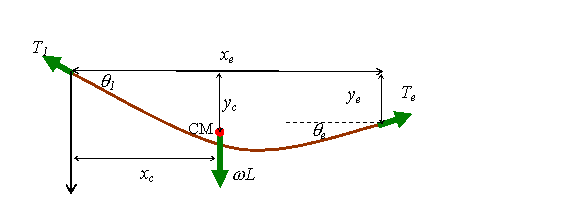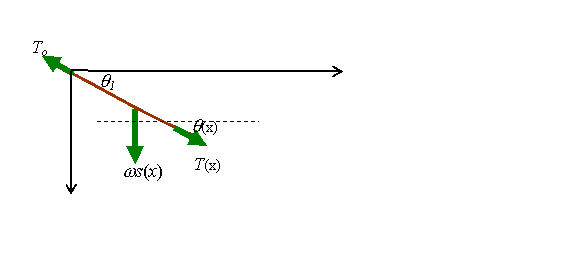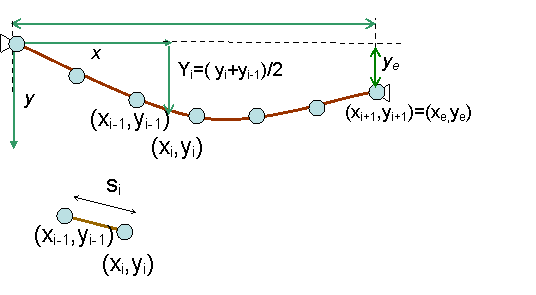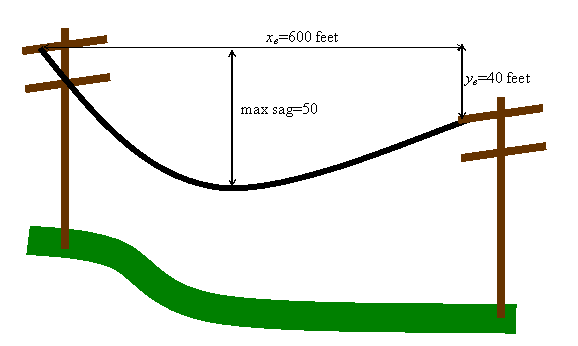Engineering 3A: Introduction to Engineering
Problem Set 5
Due
You can use Maple on any problem of this assignment, but hand in a copy of your Maple worksheet if you do.
1. In this problem you will estimate
reactions at the base of the ![]()
![]()

The force per unit length of the tower due to the wind is given by
,
where d(y) is the width of the tower at elevation y, r is the mass density of air, and CD is the drag coefficient; CD=1.5 for a square cross section. The mass of the tower is mT.
a. Derive an expression for the horizontal force distribution fD(y) in terms of r, CD, a, b, h, and vm. You can neglect the wind force acting on the pyramidion in this problem. 3 points
b. Draw a free body diagram showing all forces acting on the monument. 3 points
c. Calculate the reaction forces and moment at the base of the pyramid. 5 points
d. Evaluate your answers for a hurricane with wind speed at the top vm= 100 meters per second (229 mph) and approximate dimensions for the tower: a=10.5 m, b=16.8 m, h=150 m, mT=8.2x107 kg. 3 points
e. The foundation consists of four deep piles. While these piles can support very large compressive forces, they are at risk of being pulled from their footings if the piles are placed in tension. The tower supports may be modeled as pinned at the downwind pair of footings and on rollers at the upwind pair. Draw a free body diagram showing all forces acting on the tower. 3 points

f. Calculate the reactions at the upwind and downwind pairs of supports. Are any of the piles in danger of being pulled from their footings? 3 points
g. EXTRA CREDIT: Use
the word pyramidion casually in conversation at dinner. Briefly summarize the
conversation. 3 points
2. In this problem, you will calculate the normal stress (force per unit area)
in the walls of the

a. Find the mass density of the shaft in terms of mS, a, b, c, and h. Evaluate the answer for the actual dimensions for the tower: a=10.5 m, b=16.8 m, h=150 m, c=8 m, mT=8.2x107 kg, and mP=3x105 kg. 3 points
b. Calculate the
axial force f(y) (in

d. Finally, plot the stress (force per unit area) in the
tower walls. Compare the maximum stress with the compressive strength of the
marble and granite used for the walls of the tower, which is approximately 100 MPa=108
3. A flexible, inextensible cable of length L is suspended between two points; one at (0,0) and the other a (xe,ye). The weight per unit length is w. The cable takes on a shape described by y(x). You will use Excel to calculate the shape of the curve in the second part of this problem, but for now think of this shape as known.

Let T1 and Te be the cable tensions at the cable endpoints (0,0) and (xe,ye), respectively. A free body diagram showing all forces acting on the cable just below the attachment points is shown below:

Here, q1 and qe are the angles subtended by cable and the horizontal at the endpoints, and xc is the position of the center of mass for the suspended cable.
a. Find expressions for T1, Te in terms of w, L, q1 and qe. 2 points
b Find an expression for the horizontal coordinate xc of the center of mass of the cable in terms of xe, ye, and q1 and qe. 1 point
c. A free body diagram showing all forces acting on the section of the cable between the point (0,0) and (x,y(x)) is shown below. Here, s(x) is the length of cable suspended between (0,0) and (x,y(x)). Show that T(x)=T1cosq1 /cosq(x). 1 point

d. Use Excel and the principal of minimum potential energy to find the shape of
the cable and the tension T(x) along the cable.
To accomplish the path optimization, divide the cable into N segments as shown. The weight of the ithsegment is given by wi=wsi, where si is the segment length. The energy of the ith segment is Ei=-wiYi=-wi(yi+yi-1)/2. You want to minimize the total potential energy for the cable, subject to the constraint that
xe Have excel calculate the horizontal position xc of the center of mass of
the hung cable using the answer to part (b). Plot the cable shape and a
vertical line at x=xc
showing the horizontal position of the center of mass. Calculate the tension in the first segment using the
expression for T1 arrived
at in part a. The tension in subsequent sections can be found using the
relation in part c. Plot the cable
tension T(x)/(wL) as a function of position x along the cable. Show your results for a cable of length 2 with xe=1, and each of ye=0 and ye=1. 10 points e. The electric transmission cable shown has a weight
density of 30 pounds per foot. It is to
be strung over a 600 foot span (xe=600) and connected to a pole 50
feet below the start point . Cable sag should not exceed 50 feet from the
initial point. Determine the minimum cable length required and the tension in
the cable. 3 points EXTRA CREDIT AND VALUABLE PRIZES: Program Excel to find the
vertical position yc of
the center of mass of the cable, and plot its exact location on the graph. 3 points


